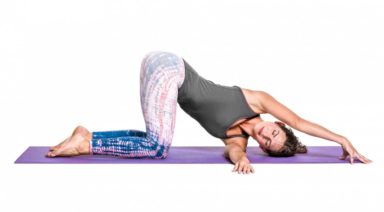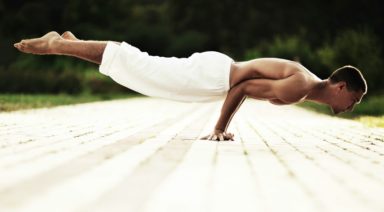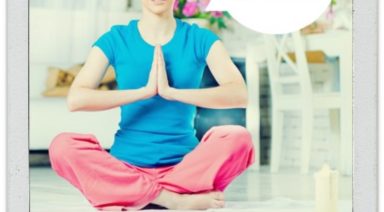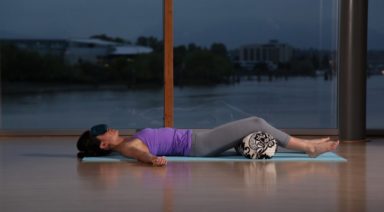Yoga and Developing Proprioception

Balance plays a pivotal role in our lives whether we notice it or not. We are constantly bombarded with external forces that disrupt our equilibrium. So much so, that we often fail to notice, as our bodies are so effectively equipped to deal with such disturbances. We do, however, notice when our systems fail us, resulting in injury or an embarrassing moment, or even worse, both! Understanding balance in its entirety makes it much easier to comprehend movement, appreciate how incredible our bodies truly are, and realize how something like yoga can develop abilities that we didn’t even know we possessed.
There are three systems in the body that contribute to the function of balance: the visual system, the vestibular system and the proprioceptive system. The visual system contributes to the execution of balance as it provides feedback as to where we are in space. The vestibular system is a network of canals in the inner ear which supply information of our head’s position (tilted, rotated, flexed or extended). The proprioceptive system is composed of sensory receptors in the muscles and tendons that inform the central nervous system as to the varying lengths of muscles, as well as force loads traveling through tendons. This notifies us as to how and where our body and limbs are oriented in space.
The human body has many regulating control systems that function via the nervous system. Receptors exist in our muscles which recognize when the length of the muscle fibers are changing. These act as a protective mechanism for the muscles. With excessive lengthening of a muscle, a reflex will be initiated which will cause the muscle to contract in order to prevent a ligament sprain or muscle strain injury. A similar regulation system exists in tendons, but it instead is dependent on the force being loaded through the tendon rather than on its length. These two regulatory systems of the muscles and tendons contribute to what is known as proprioception.
Proprioception is the new catch term. Rehabilitation programs are now focusing their attention on muscle coordination and muscle inhibition with the intention of improving muscle firing (contracting) patterns. Throughout our lives, we develop motor patterns which are essentially the blueprints that muscles follow in order to accomplish a movement task such as walking or even chopping up vegetables. Typically, muscular weakness, inhibition (muscle not firing properly), and / or pain will cause a normal motor pattern to become abnormal.
For example, the primary function of the gluteus maximus (buttock muscle) is to extend the hip. However, many people have gluteus maximus muscles that are either inhibited or weak. Therefore, the hamstrings or lumbar spine (low back) erector muscles are forced to facilitate hip extension. Due to this novel, aberrant, motor pattern, these individuals commonly complain of tight hamstrings, irritated sacroiliac joints, and / or chronic low back pain. The probability of injury increases dramatically, as does the inefficiency of movements when muscles are regularly recruited to compensate for weakness, inhibition or pain. These abnormal patterns can be corrected; however, they do require specific rehabilitation.
When an individual’s balance is jeopardized by external factors such as being bumped into or slipping on ice, the correct muscles must be prepared to engage immediately. Proprioceptive rehabilitation focuses on training muscles to accelerate their ability to achieve maximum contraction. (Liebenson, p. 529) This is why training on unstable surfaces such as wobble boards and Bosu balls is currently so popular. By training on an unsteady surface, balance is constantly being challenged. The correct muscles must contract rapidly in order to counteract the forces that the disrupted balance is placing on the body. When muscles can respond quickly to perturbations, injury is less likely and performance is more likely to be enhanced.
Proprioceptive training is relevant for all people in all stages of life. With youth comes silly antics, sports and activities that place us at an increased risk of injury, despite relatively strong, healthy bodies. With age, our vision becomes diminished and our vestibular system begins to deteriorate; however, our proprioceptive system can be quite well preserved. As these changes occur throughout our lives, it is obvious that our balance becomes increasingly endangered. Decreased bone density is commonly associated with increasing age, as is the concern for deficient balance. Therefore, it only makes sense that fracture due to falls is the next concern to consider in this equation. The risks associated with hip fracture in the elderly are severe and often fatal. Proprioceptive training can aid in the prevention of falls and the subsequent concerns of pneumonia and death. Hence, in our younger, untamed years, having a well developed proprioceptive system will aid in the avoidance of plaster casts and time away from the activities we love. Similarly, in our elder years it will assist in the evasion of falls and succeeding complications.
Now that the importance of a healthy proprioceptive system has been made frighteningly clear, it is time to discuss further, how this can be achieved. The soles of the feet, the sacroiliac area and the neck are the three most richly supplied areas of the body with proprioceptors. (Liebenson, p.515) Due to this fact, these areas can be most affected by proprioceptive training. A technique now being used is known as sensory motor stimulation (SMS). The body creates motor patterns which can be altered both negatively and positively. The principle behind SMS is that abnormal blueprints can be corrected by reeducating the nervous system. (Liebenson, p.514). This learning comes from challenging the sensory system to convey messages appropriately and quickly to muscles that are required to fire both rapidly and maximally.
In yoga, it is taught that the longitudinal and transverse arches of the foot should be lifted. This means that both the inside and outside of the foot should lift while ensuring that all four corners of the foot remain in contact with the floor. The toes should be spread and should not be used as a lever by which to maintain lift through the arches. Therefore, they should gently rest on the ground. This “yoga foot” helps to increase the sensory feedback to the CNS, therefore improving the stability of the body in the upright position. (Liebenson, p.518) Working with the yoga foot through poses will heighten the sensory feedback from the body, especially during balance poses during which the proprioceptive system is ultimately challenged. Via this challenge, great improvements to the system can be made.
As certain poses become less of a challenge, increasing the demands on the systems of balance will allow for continual improvement. Some balance poses will stress the system more than others. However, the demand will be determined by the skill level of the practicing yogi. For example, for an instructor who has been practicing for years, revolved half moon pose is a piece of cake in regards to balance. However, Tree Pose can be a real tribulation for a beginner. This illustrates the point that balance can be both trained and improved via the practice of yoga. Drishti (gaze) plays with the visual component of balance as it often involves looking in a direction that makes the body feel unsteady. By utilizing drishti appropriately, it will further increase the difficulty of balancing in many poses, therefore providing opportunities for improvement of the balancing systems. Since the cervical spine has such a high density of proprioceptors, rotating the head to follow the correct drishti will often make us feel as though we are off balance. Again, with practice, this will become easier and with an associated enhancement of balance.
In this sort of training, it is important to ensure that the muscles are as free as possible of both scar tissue and trigger points as they can alter the ability to perform appropriate muscle firing patterns. Treatments such as Active Release Technique ® and Graston Technique ® are effective methods of ridding the tissues of such hindrances. Unhealthy tissues decrease the muscle’s aptitude to contract appropriately, initially causing the abnormal patterns. Therefore, it is ideal to attempt to have healthy muscular tissue before training.
With well developed balance comes great improvements. Balance is one very important element to a healthy neuromusculoskeletal system. If the proprioceptive system is able to adapt well to the forces placed upon it, half of the battle is won. The other half includes muscular strength and endurance which go hand in hand with proprioception. Without the former two, the latter can not optimally function. One should address the health of the muscular tissues and aim to improve the motor firing patterns, strength and endurance of the muscles. This will aid in the prevention of injury and contribute to peak performance: something which is desirable at every age.
Yoga Anatomy: Avoid Hand and Wrist Injuries

Think of the number of times your hands and wrists are connected to the earth and carry your weight in a typical Hatha Yoga practice. Like our feet, our hands frequently become a crucial foundation from which our postures build and express themselves. Sustaining mindful engagement of our hands will support a life-long practice that is free of negative stress conditions and injuries to the wrist. Let’s look at some anatomical aspects to give us empowerment and motivation to explore our unique positioning and engagement of the hands and wrists.
The wrists are formed by our 2 forearm bones (the radius and ulna). They meet dat the wrist joint where there is cluster of small bones (carpal bones). The carpal bones connect with 5 long bones (metacarpal bones) that make up the palm of the hand. From there, the metacarpal bones connect to the bones of the fingers (phalanges). The carpal bones form a tunnel through which tendons and nerve tissue pass to service the hand and fingers. One primary focus of hand engagement is to avoid collapsing into this tunnel and keeping excessive pressure from cascading into that track of muscle and nerve tissue.
One primary focus of hand engagement is to avoid collapsing into this tunnel and keeping excessive pressure from cascading into that track of muscle and nerve tissue.
Another key structural area to consider is the joint connection between the ulna and the carpal bones. If you turn your hand open (supination of the forearm and wrist), your ulna is the inside forearm bone (medial side). Unlike the radius (lateral or thumb side) that has a direct joint connection to the carpal bones, the ulna has indirect joint connection. Instead, there is a piece of fibrocartilage (designed to absorb stress forces) between the ulna and carpal bones along with a network of supporting ligaments – this area is called the Triangular Fibrocartilage Complex. When we look at the overall differences in joint connection, the radius also has a larger joint surface compared to the ulna. This gives indication that most people are best served to deliver a greater proportion of their force and energy through the radial side of the wrist than through the ulnar side.





































